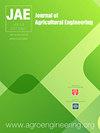Hyperspectral prediction of pigment content in tomato leaves based on logistic-optimized sparrow search algorithm and back propagation neural network
IF 2.4
4区 农林科学
Q2 AGRICULTURAL ENGINEERING
引用次数: 0
Abstract
Leaf pigment content can reflect the nutrient elements content of the cultivation medium indirectly. To rapidly and accurately predict the pigment content of tomato leaves, chlorophyll a, chlorophyll b, chlorophyll and carotenoid were extracted from leaves of tomato seedlings cultured at different nitrogen concentrations. The visible/near-infrared(VIS/NIR) hyperspectral imaging (HSI) non-destructive measurement technology, 430-900 nm and 950-1650 nm, with total variables of 794, was used to obtain the reflection spectra of leaves. An improved strategy of the sparrow search algorithm (SSA) based on Logistic chaotic mapping was proposed and optimized the back propagation (BP) neural network to predict the pigment content of leaves. Different pretreatment methods were used to effectively improve the prediction accuracy of the model. The results showed that when the nitrogen concentration in the nutrient solution was 302.84 mg·L-1, the pigment content of leaves reached the maximum. Meanwhile, the inhibition effect of high concentration was much stronger than that of low concentration. To address the problem that the SSA is prone to get in premature convergence due to the reduction of population diversity at the end of the iteration, the initialization of the SSA population by Logistic chaotic mapping improves the initial solution quality, convergence speed and search capacity. The root mean squared error (RMSE), coefficient of determination (R2) and relative percent deviation (RPD) of chlorophyll a were 0.77, 0.77 and 2.08, respectively. The RMSE, R2 and RPD of chlorophyll b were 0.30, 0.66 and 1.71, respectively. The RMSE, R2 and RPD of chlorophyll were 0.88, 0.81 and 2.28, respectively. The RMSE, R2 and RPD of carotenoid were 0.14, 0.75 and 2.00, respectively. The HSI technology combined with machine learning algorithms can achieve rapid and accurate prediction of crop physiological information, providing data support for the precise management of fertilization in facility agriculture, which is conducive to improving the quality and output of tomatoes.基于logistic优化麻雀搜索算法和反向传播神经网络的番茄叶片色素含量高光谱预测
叶片色素含量可以间接反映培养基中营养元素的含量。为了快速准确地预测番茄叶片色素含量,从不同氮浓度培养的番茄幼苗叶片中提取叶绿素a、叶绿素b、叶绿素和类胡萝卜素。采用可见光/近红外(VIS/NIR)高光谱成像(HSI)无损测量技术,430 ~ 900 nm和950 ~ 1650 nm,总变量为794。提出了一种基于Logistic混沌映射的麻雀搜索算法(SSA)改进策略,并对BP神经网络进行了优化,用于预测叶片色素含量。采用不同的预处理方法,有效提高了模型的预测精度。结果表明,当营养液中氮浓度为302.84 mg·L-1时,叶片色素含量达到最大值;同时,高浓度的抑制作用明显强于低浓度的抑制作用。针对迭代后期种群多样性降低导致SSA容易过早收敛的问题,采用Logistic混沌映射对SSA种群进行初始化,提高了初始解的质量、收敛速度和搜索能力。叶绿素a的均方根误差(RMSE)、决定系数(R2)和相对偏差百分比(RPD)分别为0.77、0.77和2.08。叶绿素b的RMSE、R2和RPD分别为0.30、0.66和1.71。叶绿素的RMSE、R2和RPD分别为0.88、0.81和2.28。类胡萝卜素的RMSE、R2和RPD分别为0.14、0.75和2.00。HSI技术结合机器学习算法,可以实现对作物生理信息的快速准确预测,为设施农业施肥的精准管理提供数据支持,有利于提高番茄的品质和产量。
本文章由计算机程序翻译,如有差异,请以英文原文为准。
求助全文
约1分钟内获得全文
求助全文
来源期刊

Journal of Agricultural Engineering
AGRICULTURAL ENGINEERING-
CiteScore
2.30
自引率
5.60%
发文量
40
审稿时长
10 weeks
期刊介绍:
The Journal of Agricultural Engineering (JAE) is the official journal of the Italian Society of Agricultural Engineering supported by University of Bologna, Italy. The subject matter covers a complete and interdisciplinary range of research in engineering for agriculture and biosystems.
 求助内容:
求助内容: 应助结果提醒方式:
应助结果提醒方式:


